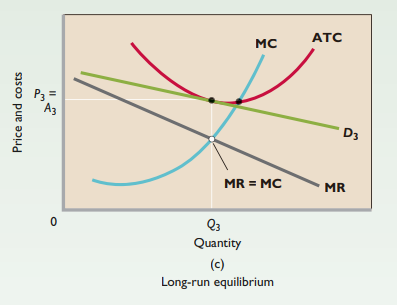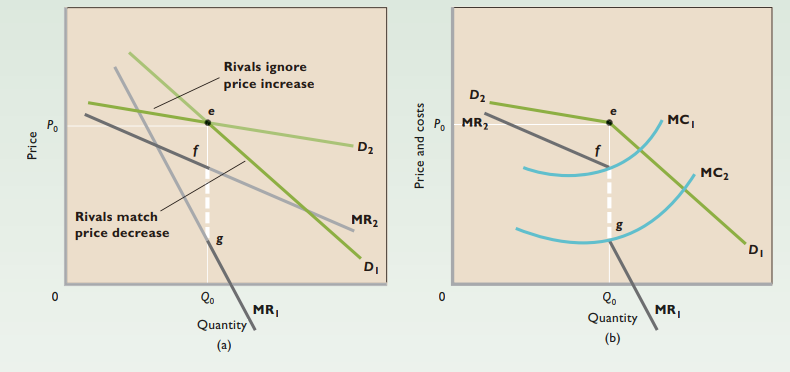Chapter 11: Monopolistic Competition and Oligopoly
Monopolistic competition - Relatively large number of sellers, differentiated products, easy entry/exit
Relatively large # of sellers
- Small market shares
- No collusion - The presence of a relatively large number of firms ensures that collusion by a group of firms to restrict output and set prices is unlikely
- Independent action - Each firm can determine its own pricing policy without considering the possible reactions of rival firms
Product differentiation - Variations of particular product
- Product attributes
- Service
- Location
- Brand names + packaging
- Some control over product prices
Easy entry + exit
- Few economies of scale
- Low capital requirements
Non-price competition - Product differentiation + advertising
Four firm concentration ratio - Ratio of the output (sales) of the four largest firms in an industry relative to total industry sales
- Very low in purely competitive industries
Herfindahl index - Sum of the squared percentage market shares of all firms in the industry
- Important to assess oligopolistic industries
- Lower index → Greater chance of being competitive
Monopolistic competition’s demand curve
- Highly elastic
- No perfect product substitutes
- Price elasticity depends on # of rivals + degree of product differentiation
Short run
- Produces where MR = MC
- May incur loss in short run

Long run
- Only normal profit (break even)
- Economic profits → Firms enter industry → Quantity increases → Economic profit decreases
- Economic losses → Firms leave industry → Quantity decreases → Economic profit increases
- Complications
- Product differentiation can prevent duplication
- In reality, entry is not as free

Efficiency
- Neither productive nor allocative efficiency
- Average total cost slightly higher than optimal
- P > MC → Underallocation of resources
Excess capacity - Plant and equipment that are underused because firms are producing less than the minimum-ATC output
Product differentiation
- Stay ahead of competitors
- Provides more range to consumers
- Trade-off b/w consumer choice + productive efficiency
Oligopoly - Market dominated by a few large producers of a homogeneous or differentiated product
- 3-5 firms
Homogeneous oligopoly - Standardized products
Differentiated oligopoly - Differentiated products
Strategic behavior - Self-interested behavior that takes into account reactions of others
Mutual interdependence - A situation in which each firm’s profit depends not entirely on its own price and sales strategies but also on those of the other firms
Entry barriers
- Economies of scale
- Large capital expenditures
- Ownership + control of raw resources
Merge 2 competing firms → Increase market share + achieve greater economies of scale + greater monopoly power
Shortcomings of concentration ratios
- Localized markets
- Interindustry competition - Competition b/w 2 products associated w/ different industries
- Import competition - Competition b/w foreign products
Game theory - Study of how people behave in strategic situations
- Payoff matrix shows payoff to each firm resulting from different combinations of strategies
- Collusion - Cooperation w/ rivals rather than work competitively/independently
- Incentive to cheat - Cheating on collusive agreement to increase own profit
3 oligopoly models
- (1) the kinked-demand curve, (2) collusive pricing, and (3) price leadership
- Why isn’t there only a single model?
- Diversity of oligopolies - Oligopoly encompasses a greater range and diversity of market situations than do other market structures
- Complications of interdependence - The mutual interdependence of oligopolistic firms complicates matters significantly
Kinked demand curve - Demand is highly elastic above the going price P0 but much less elastic or even inelastic below that price
- Rivals can either match price changes or ignore price changes
- Prices stable in non-collusive oligopolistic industries
- Even if costs change significantly, may not need to change price
- Price war - Successive and continuous rounds of price cuts by rivals as they attempt to maintain their market shares

Cartels + other collusion
- Cartel - A group of producers that typically creates a formal written agreement specifying how much each member will produce and charge
- Obstacles to collusion
- Demand + cost differences - When oligopolists face different costs and demand curves, it is difficult for them to agree on a price
- Number of firms - Other things equal, the larger the number of firms, the more difficult it is to create a cartel or some other form of price collusion
- Cheating - Collusive oligopolists are tempted to engage in secret price cutting to increase sales and profit
- Long-lasting recession - Slumping markets increase average total cost
- Potential entry of new firms - The greater prices and profits that result from collusion may attract new entrants, including foreign firms
- Anti-trust law - U.S. antitrust laws prohibit cartels and price-fixing collusion
Price leadership - The dominant firm initiates price changes and all other firms more or less automatically follow the leader
- Infrequent price changes
- Communications of price changes
- Limit pricing
Oligopoly + advertising
- Product development + advertising less easily duplicated than price cuts
- Positive effects
- Diminishes monopoly power
- Lowers consumers’ search costs
- More economic efficiency
- Negative effects
- No info about price or quality
- Based on misleading claims
- Establishes brand loyalty + monopoly power
Oligopoly + efficiency
- Neither productive nor allocative efficiency
- No regulation of loophole monopoly power